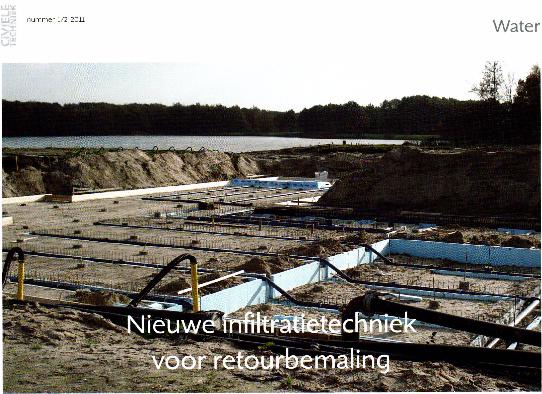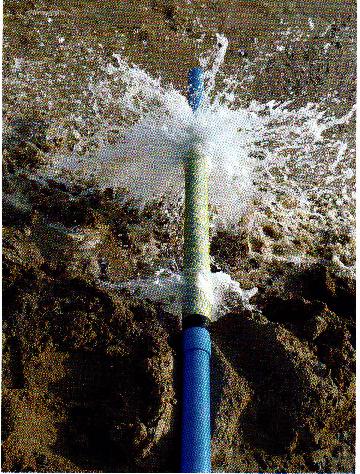Modeling subsurface flow of water: losses and gains
Manel Rahrah
Supervisor: Fred Vermolen
Site of the project:
Veurse Achterweg 10
2264 SG Leidschendam
Supervisors Fugro GeoServices BV:
B. Snacken, MSc
Ir. H.G.J.W.A. Wolfs
Project adduced by: Foundation O2DIT (Research and Development Sustainable Infiltration Techniques)
start of the project: December 2011
In June 2012 the
Interim Thesis
and a
presentation
has been given.
The Master project has been finished in October 2012
by the completion of the
Masters Thesis
and a final
presentation
has been given.
For working address etc. we refer to our
alumnipage.
Summary of the master project:
This MSc-project is carried out at Fugro GeoServices, which is one of the largest engineering consulting companies in the Netherlands and leader with services in the field of Geo-Research, Geo-Information and Geo-Consultancy.
Engineering Relevance
In the Netherlands the phreatic groundwater level is generally located shallow below ground surface. In order to achieve dry building sites with an excavation level below the groundwater level, the groundwater level should be lowered. Therefore drainage systems are installed. A drainage system usually consists of vertical filters or deep wells of which the filters are installed in the sand layers (aquifers) from which groundwater is extracted. The extraction of groundwater is adjusted so that the groundwater level and / or hydraulic head is reduced to sufficient depth below the building site floor. Because of the extraction, the groundwater level on site and near the building site will be lowered. The drawdown is largest next to the building site and decreases with increasing distance.
Environmental regulations do not allow large amounts of extracted groundwater to be pumped into surface water systems like rivers, canals, ditches or neighboring lakes. Also the sewer is often not a solution given the (often) limited capacity. One solution is to return the extracted groundwater in the soil. The injection of groundwater, however, increases the groundwater level in and around return sources. Returning groundwater with a traditional drainage system is accompanied by a round pumping effect which increases the discharge if the injection field is located near the project site. The rebound effect can be reduced by increasing the distance of the injection field to the drainage. To obtain sufficient reductions on the building site the extracted groundwater should be injected back in the soil at relatively large distance from the building site. The ideal distance of the injection field depends on the geohydrological parameters, the amount of groundwater to be extracted and the percentage of the extracted groundwater that will have to be returned in the ground. For a small rebound effect of less than 25%, this could mean that the injection field should be arranged at several hundred meters away from the drainage.
Both in practice and in theory it is known that there are 'injection points' or preferential flow paths in the subsurface. At such points the soil absorbs significantly more water than at other depths on such a location. One of the reasons of this phenomenon is the heterogeneity of the subsurface. A significantly higher permeability is expected at these injection points or preferential flow paths.
Using these 'injection points' for injecting / returning the extracted groundwater has shown that groundwater can be returned at a (very) short distance from the extraction means without the usual negative effects of an injection field including rebound effects (higher surplus water), and flooding by groundwater elevations. Field measurements also seem to indicate that as the injection means are installed closer to the extraction means, the drawdowns at the location of the building site are achieved more quickly and the area of influence of the extraction is further reduced. Assuming the injection points and injection filters of the return sources are installed deeper than the extraction filters.
The above effect has already been established in pilot projects where the extraction and injection are combined into one source location. Groundwater is extracted with a filter in the upper part of the source and then injected into a filter in the lower part. The results indicate that using this setup the groundwater / hydraulic head drawdowns can be significant.
The question originally came from Werner Wils and drainage company Henk van Tongeren Bronbemalingen BV. More information about the industrial relevance can be found in this
report.
Research Question
Injection of extracted groundwater in the soil (sand / gravel formations / aquifers) from which it is extracted, raises the groundwater level around the injection point. The classical hydrological models are based on calculations using the superposition principle and laminar groundwater flow according to the Darcy equation. At equal geohydrological parameterization and configuration of the extraction and infiltration means, the drawdown of the groundwater level / hydraulic head by the extraction is equal to the increase of the hydraulic head by an equal injection (principle of superposition). According to Darcy's law, if groundwater is extracted and fully (100%) injected at the same location into the same aquifer, there will be neither drawdown nor raising of the hydraulic head.
Using a new injection technique, where water is injected (usually with high pressure) on a very limited filter length at an "injection point", measurements differ significantly from the expected values based on the classical Darcy's law. An injection point characteristically absorbs more water than other levels in the subsurface. This implies local higher permeability. Even if this local higher permeability is taken into account, the measured groundwater / hydraulic head drawdowns and elevations do not correspond to the results calculated using the Darcy equation. The premise is that the groundwater flow at the location of the injection point is not laminar and therefore the equation of Darcy is not valid.
Research Approach
A research group at the University of Stuttgart, led by Prof. Helmig (Institut fur Wasser-und Umweltsystemmodellierung), is engaged in research of hydrological models based on the Darcy-Forchheimer formalism for the relationship between pressure and fluid velocity. In this approach of groundwater flows in porous media a quadratic term appears for the speed. In this application the velocity term can be significant so that the nature of groundwater flow may change. The first thing to examine is whether this additional term can cause turbulence of groundwater flow.
In addition, the effect of anisotropy will be incorporated into the permeability term where the permeability in the (normally) horizontal directed flow depends on the size of the flow (in the tangential direction). This will hinder the vertically directed flow so that the injected water will be allowed to penetrate into the soil over a larger distance. A second task in this project is to quantify the relationship between the magnitude of the flow, change in the permeability tensor (especially the (normally) horizontal direction) and the distance over which water flows in (almost) vertical direction.
Another focus will be that, especially in turbulent flow, pressure variations occur in the porous medium. Sand / gravel layers (aquifers) are not rigid, but a more or less elastic matrix. Variations in pressure due to the turbulent flowing water will evoke some vibration frequencies in the porous medium. These vibrations would be of utmost interest at a certain frequency to explain / describe the measured phenomenon. Propagation of vibrations could also explain the relatively broad scope of the phenomenon around an injection point.
The second part of the task concerns an adaptation of a physical model such that the experimental results can be reproduced computationally. The third task will involve a more complicated, but also more physical approach of model adaptation. In this approach, we will scrutinize the use of Biot's Theory for poro-elasticity, where flow in porous media is combined with mechanical deformations of the aquifer in which water is injected. Mechanical deformations of the porous media induce changes in the porosity, which will result into permeability changes. In this task, we will analyse whether poro-elasticity can give any contribution to understand the long-lasting horizontal flow pattern in the subsurface at an injection point. Insight in the flow patterns can be obtained by combining elasticity and poro-elasticity of the porous media in the models with the Darcy-Forchheimer's formalism. This approach will need a careful discretization method since a (non-linear) saddle-point problem needs to be solved.
The simulation software will have to be developed in a great extent. Furthermore simulations with the code developed at the Stuttgart University will be carried out.

Construction site with the innovative drainage / injection system

DSI-retourfilter

Contact information:
Kees
Vuik

Back to the
home page
or the
Master students page of Kees Vuik


![]()
![]()